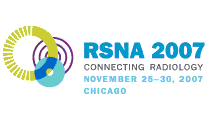
Abstract Archives of the RSNA, 2007
Ho Kyu Lee MD, PhD, Presenter: Nothing to Disclose
Wendy R.K. Smoker MD, Abstract Co-Author: Nothing to Disclose
Toshio Moritani MD, PhD, Abstract Co-Author: Nothing to Disclose
Jinsuh Kim MD, Abstract Co-Author: Nothing to Disclose
The authors recently encountered two patients with large MCs who presented with headache and papilledema. The purpose of this study is to evaluate clinical presentations and MRI features of patients with large MC.
We retrospectively identified 15 patients with large MC (F:M=9:6, mean age=53.9 years), who underwent brain MR examinations between July 2004 and December 2007. No patient had a brain neoplasm or cranial surgery. The control group consisted of 37 normal adult subjects with no symptom suggesting intracranial of increased pressure. Measurement of MC in all subjects was performed on both axial and coronal MR images. We defined a large MC if patients met at least one of following criteria: (1) antero-posterior (AP) dimension > 17mm, which is more than 2 standard deviation above the mean AP dimension of the normal MC (mean=12.7mm) on axial image, (2) AP ratio > 0.5, which is more than two standard deviation above the mean AP ratio (mean =0.36), (AP ratio is defined as ratio of AP dimension of MC to one of the cavernous sinus on axial images), (3) lateral bulging of MC on coronal images, or (4) MC herniation into the adjacent structures such as the foramen ovale or petrous apex. Clinical presentations as well as MR findings were analyzed.
1. Bilateral enlargement of MCs was present in 13 patients and unilateral enlargement in 2 patients. Mean AP dimension of the large MC was 18.8±4.1mm, and mean AP ratio was 0.57±0.11.
2. Common clinical presentations were visual disturbance with or without papilledema in 10 (67%), headache in 6 (40%), and CSF rhinorrhea in 3 (20%).
3. MR features were empty sella in 10 (67%), widening of the foramen ovale in 8 (53%), herniation into the petrous apex or cephalocele in 6 (40%), and widening of the perioptic CSF space in 4 (27%).
Large MC commonly occurred in patients with symptoms of intracranial hypertension as well as empty sella. We believe a large MC is a pathologic condition reflecting intracranial hypertension.
Meckel’s cave (MC) is a dural recess of the trigeminal ganglion near the apex of the petrous portion of the temporal bone. We hypothesized large MC may be related to intracranial hypertension.
Lee, H,
Smoker, W,
Moritani, T,
Kim, J,
Large Meckelís Cave: Clinical Presentations and MR Features. Radiological Society of North America 2007 Scientific Assembly and Annual Meeting, November 25 - November 30, 2007 ,Chicago IL.
http://archive.rsna.org/2007/5013865.html

